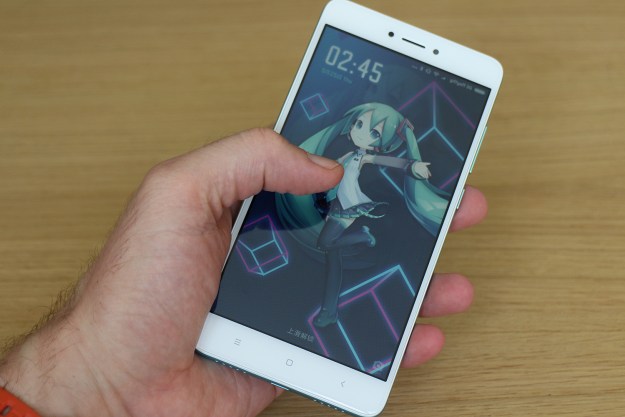
“With a brilliant design, big battery, and bargain price, the Redmi Note 4X is crying out for international support.”
- Compact, smart design
- Long battery life
- Competitive price
- Limited connectivity
- Import only
Xiaomi may capture headlines for stunning, high-power smartphones like the Mi Mix and the Mi 6, which are great devices; but arguably the company does low-cost hardware with strong spec lists better. Its latest is the Redmi Note 4X, an update to 2016’s Redmi Note 4, which costs about $160 depending on the color you choose. That’s not very much money for a smartphone today, especially one with features like the Note 4X.
Like all Xiaomi phones, if you want to own one outside China, you have to use an import service to get it. It’s not difficult, but it can be a challenge down the line if the phone breaks, and making sure it connects to your chosen network. It’s extremely tempting to pick up a $160 phone that looks like it should cost twice that, so should you?
We’ve been using the Redmi Note 4X for the last two weeks to find out, and the answer is no. It’s a fantastic phone for the price, but the dealbreaker is its lack of 4G LTE connectivity.
Stylish design
If you’re familiar with the Redmi Note 4, little has changed with the Redmi Note 4X. Two small screws on both sides of the MicroUSB charging port have been removed for a cleaner look, and the antenna bands have been minimized and replaced by shiny strips, rather than cheap-looking white plastic. Nothing major, but enough to make the Note 4X a modern, sleek looking phone you’ll be proud to hold.
It’s quite thick at 8.5mm, but it’s comfortable to hold due to a 2.5D piece of curved glass over the screen, and a perfectly curved aluminum rear panel. Cradling the Redmi Note 4X, you’ll find it ergonomical. The power button falls easily to thumb or finger (depending if you’re left or right handed), and the rear-mounted fingerprint sensor is ideally placed, so your finger avoids the camera lens above it. It’s a grippable phone, and one that doesn’t feel too slippery.
If you like phones without much branding, the Redmi Note 4X will please you. Only a Mi logo is etched into the back, and the usual three Android capacitive keys sit below the screen, glowing when the phone is awake. The Note 4X is available in several different colors, including silver, gold, black, and pink, plus the light green version seen here. The light green has a slight matte effect, but retains a decent light-catching glow, as well as a subtle, tactile texture. Phones in multiple colors are becoming more popular, and to find such unique hues on a phone so competitively priced is very welcome.
Minimalist, stylish, and pleasant to hold, it’s surprising the Redmi Note 4X costs so little.
Bright screen, long-lasting battery
The Redmi Note 4X has a Pixel XL-size screen, and it’s big, bright, and beautiful. It’s not an AMOLED panel though, but an IPS LCD screen that measures 5.5-inches and has a 1920 x 1080 pixel resolution. It can’t compete with the Pixel XL, the Galaxy S8, or the LG G6; but holds its own against the OnePlus 3T, various Honor phones, and even some more expensive Huawei devices like the P10 Plus.
Minimalist, stylish, and pleasant to hold, it’s surprising the Redmi Note 4X costs so little.
There are plenty of customization options. A Reading Mode reduces glare and cuts down on sleep-disturbing blue light, plus adjustments can be made to the color and contrast, helping tailor the screen’s look to your personal preference. It’s also very bright with a maximum output of 450 nits, and it’s easily viewable in bright sunlight with the brightness slider cranked right up. The ambient light sensor is quite aggressive though, and it doesn’t recognize when you’re looking at the screen, resulting in the brightness dimming at inopportune moments.
A massive 4,100mAh battery keeps the screen on — that’s enormous compared to most flagship smartphones. The result? At least two days use. Yep, we said, “at least.” Leave the phone on standby, and use it normally through the day, and you’ll be charging on the third day. The Redmi Note 4X sips from a vast well of battery power. Unfortunately, that well isn’t quickly replenished, due to no fast-charging system, so plan for a two hour recharge when it’s close to empty.
Android Marshmallow, and solid performance
Here’s the big difference between the older Chinese Redmi Note 4 and the new globally compatible Note 4X: It has a Qualcomm Snapdragon 625 processor inside, rather than a MediaTek chip. The Redmi Note 4X is almost identical to the international version of the Note 4 released after the Chinese version though. Confused? Don’t be, just remember the Redmi Note 4X is the model to buy, and you’ll be fine. There’s a version with 3GB of RAM and 32GB of storage, and another with 4GB of RAM and 64GB storage space. Our review model is the former.
Judging whether a smartphone has enough performance isn’t that complicated. We use the phone daily, for a similar range of tasks, and if it’s slow, buggy, or annoying, it gets a big strikethrough next to its name. We’d never expect to see this with a device that costs $500 or more, but one that costs less than $200? That seems more likely. The fantastic news here is the Redmi Note 4X is strikethrough free.
After a solid hour playing games, reading email, checking social networks, and generally zipping between the home screens and different apps, the Redmi Note 4X hadn’t stuttered. Its very hard to argue against a phone that costs so little, yet performs so well. Running AnTuTu 3D benchmarking test returned a 62,771 score, while 3DMark’s Slingshot Extreme returned a score of 461, neither of which set the record charts alight, but are consistent with the Snapdragon 625-powered Huawei Nova.
The phone runs Android 6.0.1, with Xiaomi’s MIUI 8.2 user interface over the top. It’s one of the best third-party user interfaces out there, with the biggest change over stock Android being the lack of an app drawer. All your apps are spread over multiple home pages, just like Apple’s iOS. Android purists will be annoyed by other small changes, such as the altered notification shade, custom icon designs, and other visual tweaks throughout the operating system. Google Play came pre-installed on our phone, but be aware that due to the custom nature of MIUI, some apps — such as the updated Netflix app — may not work. It’s a rarity this happens though, and every other app we used operated without a problem.
Is it all good news? No. The Redmi Note 4X is still a mid-range phone, with a mid-range processor, and a custom UI. This means scrolling isn’t always buttery smooth, some of the transitions are a beat too slow, and in some games when the going gets really tough — driving the fastest cars in Reckless Racing 3, for example — there’s evidence of frame rate drops. Android Pay also won’t work, as there’s no NFC onboard.
Still, for the price, the Redmi Note 4X is a solid performer. It’s a shame it does not come with the latest version of Android.
Good camera
A 13-megapixel rear camera sits at the top-center, and it’s good. That’s right. Good. It’s not often we get to praise what has become a very typical camera setup, but the pictures we took with the Redmi Note 4X were pleasing, offering detail, and handling challenging light in a satisfactory way.
It’s still far from perfect, and the f/2.0 aperture does limit its capabilities in low light, but show it some sunny skies or an expansive landscape, and the results are eyebrow-raisingly good. Yes, it washes out the sky on overcast days, and no, it doesn’t have two lenses or a wealth of different modes. However, take regular photos in everyday situations and you’ll likely be happy with the results.
The camera is quick, and we love being able to use the fingerprint sensor to take a photo in the app — it’s really convenient.
Warranty, availability, and price
It suffers because it doesn’t support the most commonly used 4G LTE bands for the U.S.
The Xiaomi Redmi Note 4X isn’t sold in the U.S., the U.K., or officially any places outside China and Xiaomi’s usual markets. That means you have to import it if you want one. Ours came from GearBest, an importer of Chinese electronics we’ve used several times, and the experience has always been good.
What does this mean if it goes wrong? It comes with a three-day dead-on-arrival warranty, a 45-day money back guarantee, plus a one-year warranty to cover against defects. For after sales service, you’ll still have to communicate primarily by email and the post. If you break the phone due to mistreatment, drop it in the bath, or change the software and brick the phone, it won’t be covered; but that’s to be expected.
How much is it? The price varies due to currency fluctuations, but you won’t pay much more than $200. At the time of writing, the light green model we tested is available for just $167 through GearBest with free delivery. There are other importers out there, and prices for the Redmi Note 4X will vary between them.
Our Take
A real smartphone bargain, the Xiaomi Redmi Note 4X has battery life to spare, but misses out on crucial connectivity options.
Is there a better alternative?
The Redmi Note 4X, like the vast majority of Xiaomi phones, suffers because it doesn’t support the most commonly used 4G LTE bands for the U.S. and the U.K., which restricts its connectivity to 3G. You must be prepared to accept this, if you buy one. The frustrating thing is, if the Note 4X supported all international bands, it would be unstoppable in terms of value.
We consider 4G LTE connections to be essential, where available, and therefore suggest you look at the $250 Honor 6X, the $200 ZTE Axon 7 Mini, or the $230 Moto G5 Plus. All three are more expensive than the Note 4X, but they operate properly in the United States.
How long will it last?
Xiaomi does update its software, but the phone doesn’t run Android 7.0 Nougat, or have the latest security update from Google. This is a common compliant with many phones, not just those made by Xiaomi. It may get updated to Android 7.0 Nougat, but don’t expect major updates down the line.
The phone itself is not especially durable, and isn’t water resistant; but the body is made from plastic and metal, so should resist average wear and tear from regular use. Due to its relative low power, depending on your needs, it will likely need replacing after two years of use.
Should you buy it?
Not if you value 4G LTE connectivity. It’s really the only reason not to pick up the Redmi Note 4X, which is otherwise astonishingly good value for money. It did everything we asked, has battery power to spare, a good screen, and a solid if unremarkable camera. All for less than $200.
Editors' Recommendations
- Poco’s X4 Pro will look familiar to fans of another phone
- Redmi’s Note 11 global launch comes with a few big surprises
- Redmi India’s rebranded Note 11T 5G could be its last smartphone of 2021
- Xiaomi joins the affordable 5G phone battle with the new Redmi Note 10 5G
- Xiaomi Mi Smart Band 4 impressions: All the fitness tracker you need




















